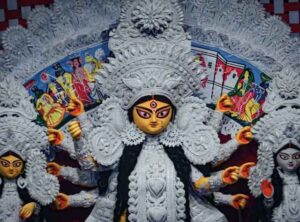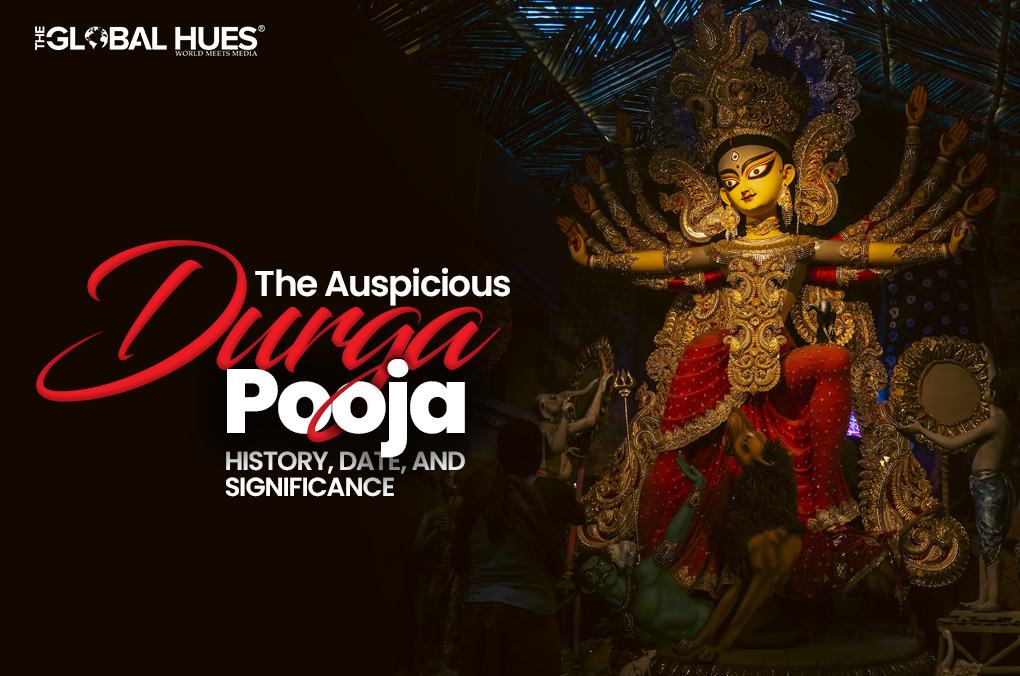Durga Pooja is the most beloved festival of the people of West Bengal. This festival celebrates the victory of the goddess Durga over the evil buffalo demon Mahishasura. Celebration of the festival takes place through scripture recitations, chanting mantras, parades, folk art performances, spending time with family, and visiting the pandals. In this article, we look into the festival’s origin, where, and how one can celebrate the festival.
Origin Of Durga Pooja
Durga Pooja is a festival that lasts for ten days, and the last four days Saptami, Ashtami, Navami, and Dashami are celebrated with much grandeur and gaiety. According to the folklore, the zamindars of Dinajpur and Malda initiated the first Durga pooja in Bengal. In 1911, after the British changed their capital to Delhi, many Bengal officers who came to work here celebrated the Pooja in Delhi. The tableau of Durga features her four children- Kartikeya, Ganesha, Saraswati, and Laxmi. Kumartuli is a neighbourhood in North Kolkata which has a legacy of idol-making.
Legend Of Durga Pooja
According to the legends, the goddess Durga is the creation of the three powerful Gods in the Hindu Pantheon- Brahma, Vishnu, and Mahesh. Mahishasura impressed Lord Brahma with his tapasya, and he granted him a boon that only a woman can kill him. Feeling invincible, he defeated the Devas, wanting to conquer Heaven, Hell, and Earth. The Tridevas used their power and created an energy that took the form of Devi Durga. The newborn Durga, riding a lion, killed Mahishasura. The giant idols in the Durga pandals depict the scene of the Goddess Durga killing Mahishasura.
When Is Durga Pooja?
The festival of Durga Pooja coincides with Navratri and Dussehra, the ten-day celebration honouring different gods and goddesses. On the tenth day, people worship Goddess Durga. During the last day of Durga Pooja, the idols leave the pandals, with a procession of devotees behind it, and the devotees submerge the idols in the water. This year, the festival starts on October 20 and ends on 24th 2023.
How is Durga Pooja Celebrated?

The pandals are the centre of attraction of the festival, and every year, idols are designed based on a theme and erected all over different cities. Every year, many societies compete with each other to make the best pandal. Food is one of the main attractions of the Durga Pooja festival, from street food to local Bengali cuisines; this festival is heaven for all food lovers. CR Park in Delhi is the hotspot since the ground has different pandals during the festival. Now, let’s look at the celebrations that take place each day.
-
Day 1: Mahalaya
The celebrations of Durga Pooja begin on Mahalaya. During this, people prepare for the arrival of the Goddess with her children. An auspicious ritual called Chokkhu Daan happens on the first day. Chokkhu means “eyes” and Daan means “to give”. It is the day when artisans paint the eyes of Maa Durga’s idols. One believes that the goddess descends to the Earth during this ritual.
-
Day 2-5: Days of Honouring
People honour the goddess by doing different rituals for gods such as Kumari (the goddess of fertility) and Lakshmi (the goddess of wealth). During these days, the pandals echo with the chanting of mantras and offerings to the goddess.
-
Day 6: Shasti
On this day, the idol of Durga is worshipped and adorned with weapons gifted to her by different gods to kill Mahishasura. On this day, People bring the idols to their homes or place them in decorated pandals, and then these idols are adorned with flowers, clothes, jewellery, vermillion, and various kinds of sweets.
-
Day 7: Saptami
On the day of Saptami, a ritual named ‘Pran Pratisthan’ takes place to invoke the goddess’s holy presence into the idol. It involves a small banana plant known as Kolu Bau, which is bathed and draped in a saree and then used to transport the goddess’s energy.
-
Day 8: Ashtami
Ashtami is the most crucial day in the ten-day festival pooja, and one offers prayers to the goddess to prepare her for battle. The offerings are grand, such as the 108 lotus flowers and earthen lamps, fruit, hibiscus flowers, saris, uncooked grains, jewellery and a crown of 108 bel leaves.
-
Day 9: Navami
Navami marks the final day of the long-drawn battle between Durga and Mahishasura. On the occasion, the ritual of Kumari Pooja happens where little girls dress up like the goddess. They receive offerings of food, clothes, and other gifts.
-
Day 10: Vijayadashmi
The last day of the festival is about the victory of the goddess Durga over the demon. People carry the statues in trucks, the devotees follow the trucks, and then people submerge statues in water. Married women say goodbye to the goddess by giving offerings of red vermillion powder and then smearing it on themselves. The vermillion powder is the symbol of marriage and fertility.
Where Should You Celebrate Durga Pooja?
-
Kolkata (West Bengal)
Durga Pooja is the most important festival of the year in Kolkata. One can see huge processions carrying the idols of the goddess through the streets to the sound of the drums and hear the chanting that follows them. Devotees eat the prasad after completing the pooja. The eateries serve traditional dishes like Khichuri, Luchi, and Ilish Bhapa. The Kumartuli Park pandal features religious themes every year. It is one of the oldest in the city. This place lies near North Kolkata in Bagbazar.
-
Guwahati (Assam)
The Bishnupur Puja Committee organises the largest Durga pooja festival in the region. The 100-ft Durga statute in the pooja is the centrepiece, and it is made entirely out of Bamboo.
-
Mumbai (Maharashtra)
The celebration in Mumbai was started by those Bengalis who had come here for better opportunities. A grand pooja happens at Shivaji Park for all those Bengalis who cannot experience the festival in their hometown.
In conclusion
The season of festivals is starting soon, and one of the beloved festivals for the Bengalis is Durga Pooja, a ten-day-long festival. The pandals are the most beautiful thing one can see, along with the beautiful idol of the goddess in different pandals. It is also a food haven for all the food lovers who visit the pandals.




